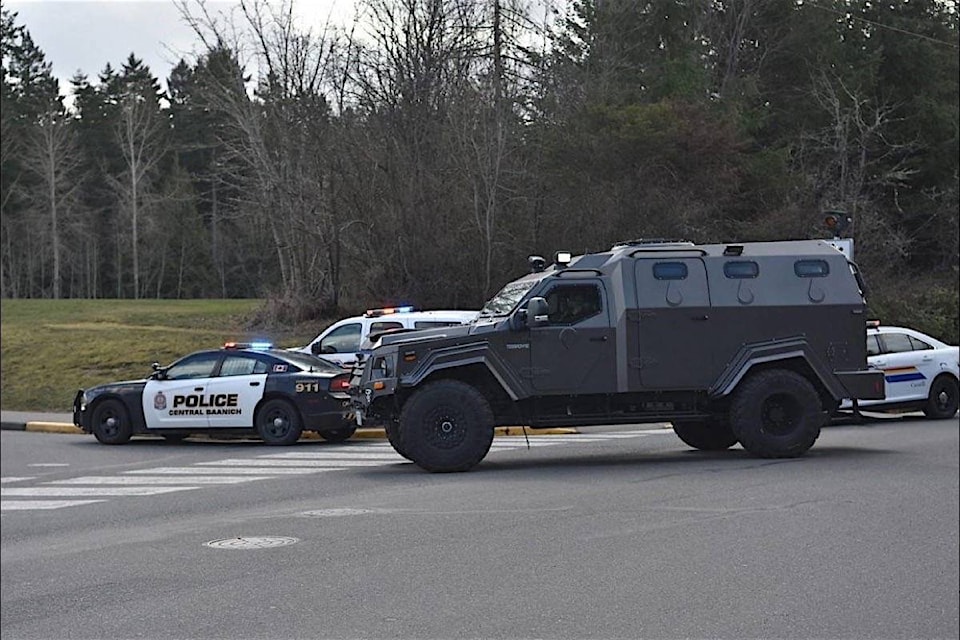Credible reports of armed intruders are rare for B.C. schools, but they do happen.
A middle school in Central Saanich is a recent example, after the administration received multiple student reports on March 1 of a man hiding in bushes near the school with what may have been a weapon.
As most schools do in an annual drill, a lockdown went into effect and police were notified. Doors are locked, students go into closets or under desks, blinds are closed, lights turned off and everyone keeps quiet while the threat is assessed.
In Prince Rupert School District 52, if there is an intruder, a lockdown is announced over the PA system. Students and staff will stay in classes quietly, with the lights out and doors locked until the principal gives an all clear notice. RCMP will go to the school as soon as a lockdown is called.
“We have called one lockdown this year for a very low level incident. The protocol was very efficiently deployed, a testament to staff and students rehearsing lockdown protocol,” said Ken Minette, school district superintendent, in an email.
Following the Parkland, Florida school shooting, secretary for the District Parent Advisory Committee, Dianna Caputo, said what she’s hearing is that everyone is grateful for living in Canada.
READ MORE: 17 dead, suspect identified in Florida school shooting
“It’s really not a big concern other than the psychological thought of going to school for the kids when they get anxiety ridden for the lockdown scenario,” Caputo said.
Minette also said he’s not hearing from parents or teachers about any safety concerns since Parkland incident “with the exception of parents indicating that they hope we are giving advanced notice if it’s just a drill so that we are not creating more anxiety for our students.”
B.C. Education Minister Rob Fleming said communication, reporting and awareness are keys to the ministry’s system established in 2012, known as the Expect Respect and A Safe Education (ERASE) Bullying Strategy. A review for updates is currently underway.
“When you look at events south of the border, I think school districts are looking for ways they can evaluate whether what we have in B.C. schools is significant enough,” Fleming told Black Press. “A lot of it is acting on tips. Information comes from students talking in the school, that gets to a teacher, maybe a parent, and it’s passed to a principal or a school administrator.”
The ministry’s ERASE Bullying website (www.erasebullying.ca) includes a reporting tool where students can anonymously warn the administration of threats or harassment against students. That includes online harassment, to identify situations that could lead to violence.
In 2017, training for “digital threat assessment” was introduced, and 17,000 staff have completed the training. A provincial team of experts in violence risk assessment and prevention gives direct support to schools and school districts on high-risk cases and critical incidents.
Fleming notes that local school districts are ultimately responsible for security policies, but all boards of education and independent school authorities must have lockdown procedures in place.
B.C. schools are generally designed so almost all doors, internal and external, can be locked, ministry officials said. Many have policies where all doors are kept locked except one close to the office to ensure visitors check in.
Education ministry officials say many B.C. districts have gone to mandatory identification badges for school entry. Some have used the authority available under the School Act to install video surveillance cameras, which requires approval of the individual school planning council.
In Canadian culture, gun laws make life safer in B.C.
Gun amnesties have helped, Public Safety Minister Mike Farnworth said.
Don’t expect to see armed security considered for B.C. schools, despite concern about school shootings south of the border.
That’s the word from B.C. Public Safety Minister Mike Farnworth. The minister responsible for police and provincial prisons, Farnworth said the British Columbia public has confidence in the safety of schools and communities.
“In my entire time as an MLA, which is 23 years, I don’t think I’ve ever had a person contact me about what goes on down in the U.S. all too often,” Farnworth told Black Press.
“I do think there are some fundamental differences in this province, in this country. There have been situations where there have been lockdowns, and the police are on them very well, and the school districts have protocols in place.”
He credits Canada’s strict gun laws, and a culture that has adapted to urbanization from a rural tradition where hunting rifles and shotguns were widely held.
The province and police forces have hosted gun amnesties, allowing people to turn in rifles, handguns and other weapons to police with no questions asked. Anyone with an old gun that needs safe disposal can turn it in, but they should be sure and call the police first for instructions.
Police work with B.C. schools to warn of the dangers of gangs, often with former gang members describing how they were lured into the apparent glamour of drug dealing and crime. Police and border officials report that illegal guns are smuggled into B.C. from the U.S. along with drugs.
READ MORE: Students head to Florida capital to press for gun law change
School safety in B.C.
• School security decisions are made at the local level by each of B.C.’s 60 school districts, with provincial guidelines on development of common lockdown protocols and emergency response.
• Through the ERASE Bullying Strategy, the education ministry provides school districts and community partners with training in violence and threat risk assessment to help schools prevent, respond and recover from violent incidents.
• Each school district has a critical incident response team to respond to the unlikely event of a violent incident.
• The ministry is developing provincial school-police protocols so school districts and RCMP or city police provide a consistent and coordinated response to safety issues.
With files from Shannon Lough
